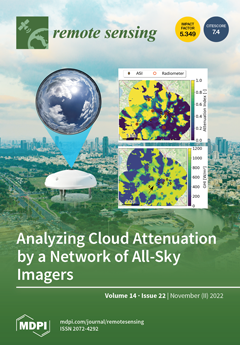Satellites are an effective source of atmospheric carbon dioxide (CO
2) monitoring; however, city-scale monitoring of atmospheric CO
2 through space-borne observations is still a challenging task due to the trivial change in atmospheric CO
2 concentration compared to its natural variability
[...] Read more.
Satellites are an effective source of atmospheric carbon dioxide (CO
2) monitoring; however, city-scale monitoring of atmospheric CO
2 through space-borne observations is still a challenging task due to the trivial change in atmospheric CO
2 concentration compared to its natural variability and background concentration. In this study, we attempted to evaluate the potential of space-based observations to monitor atmospheric CO
2 changes at the city scale through simple data-driven analyses. We used the column-averaged dry-air mole fraction of CO
2 (XCO
2) from the Carbon Observatory 2 (OCO-2) and the anthropogenic CO
2 emissions provided by the Open-Data Inventory for Anthropogenic Carbon dioxide (ODIAC) product to explain the scenario of CO
2 over 120 districts of Pakistan. To study the anthropogenic CO
2 through space-borne observations, XCO
2 anomalies (MXCO
2) were estimated from OCO-2 retrievals within the spatial boundary of each district, and then the overall spatial distribution pattern of the MXCO
2 was analyzed with several datasets including the ODIAC emissions, NO
2 tropospheric column, fire locations, cropland, nighttime lights and population density. All the datasets showed a similarity in the spatial distribution pattern. The satellite detected higher CO
2 concentrations over the cities located along the China–Pakistan Economic Corridor (CPEC) routes. The CPEC is a large-scale trading partnership between Pakistan and China and large-scale development has been carried out along the CPEC routes over the last decade. Furthermore, the cities were ranked based on mean ODIAC emissions and MXCO
2 estimates. The satellite-derived estimates showed a good consistency with the ODIAC emissions at higher values; however, deviations between the two datasets were observed at lower values. To further study the relationship of MXCO
2 and ODIAC emissions with each other and with some other datasets such as population density and NO
2 tropospheric column, statistical analyses were carried out among the datasets. Strong and significant correlations were observed among all the datasets.
Full article





